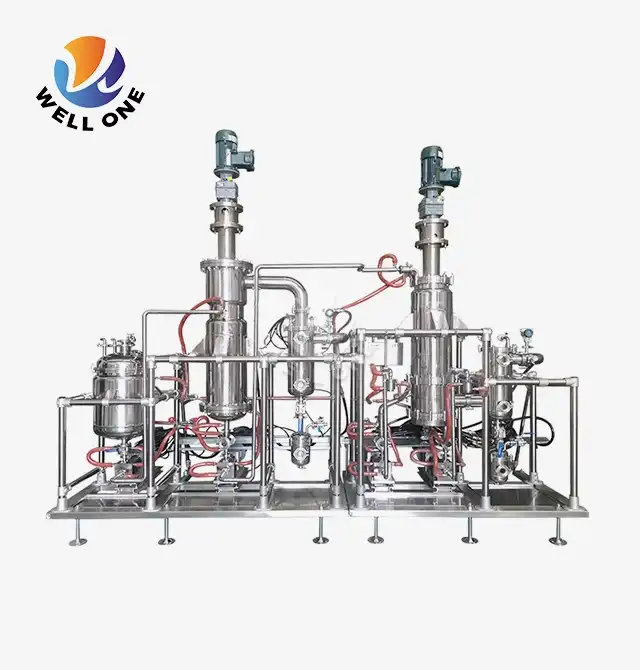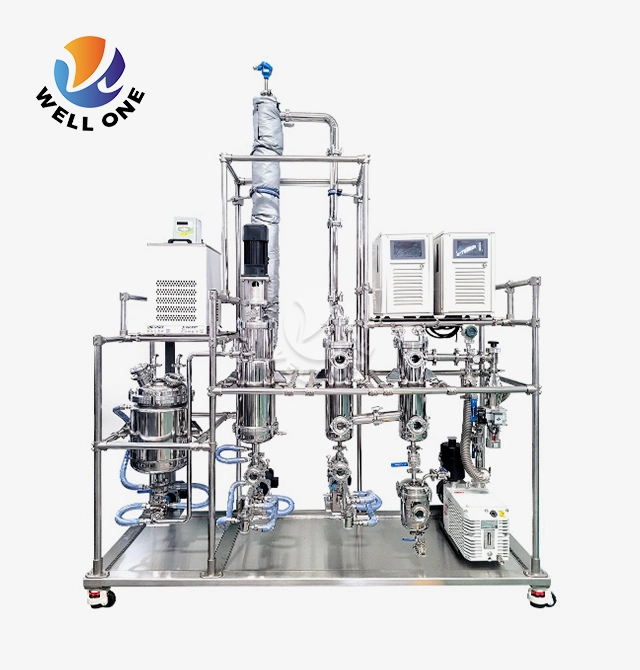How Do You Optimize the Performance of Agitated Thin Film Evaporator?
The Agitated Thin Film Evaporator is a specialized equipment designed for efficient evaporation and concentration of heat-sensitive materials. It finds applications in various industries, including food processing, pharmaceuticals, chemicals, and biotechnology. The Agitated Thin Film Evaporator's unique design allows for the creation of a thin film of the feed material on a heated surface, resulting in rapid and uniform evaporation. This process is particularly beneficial for materials that are prone to thermal degradation or fouling when exposed to high temperatures for extended periods.
The importance of Agitated Thin Film Evaporators in various industries cannot be overstated. In the food industry, they are used for the concentration of fruit juices, dairy products, and other heat-sensitive liquids. Pharmaceutical companies rely on Agitated Thin Film Evaporators for the production of active pharmaceutical ingredients (APIs) and the purification of intermediates. Chemical industries utilize Agitated Thin Film Evaporators for solvent recovery, concentration of polymers, and the processing of viscous materials. Additionally, Agitated Thin Film Evaporators play a crucial role in the biotechnology sector for the concentration of fermentation broths and the recovery of valuable compounds.
Factors affecting the performance of Agitated Thin Film Evaporator
The performance of an Agitated Thin Film Evaporator is influenced by several key factors, including:
Heat transfer efficiency: The rate of heat transfer from the heated surface to the thin film directly impacts the evaporation rate and overall efficiency of the process. Factors such as surface area, material thermal conductivity, and heat flux distribution affect heat transfer efficiency.
Residence time: The time the feed material spends in the Agitated Thin Film Evaporator determines the extent of evaporation and concentration achieved. Longer residence times generally result in higher evaporation rates but may also increase the risk of product degradation or fouling.
Feed flow rate: The rate at which the feed material is introduced into the Agitated Thin Film Evaporator affects the film thickness and residence time. Optimal feed flow rates must be determined to balance evaporation rates and product quality.
Vacuum level: Most Agitated Thin Film Evaporators operate under vacuum conditions to facilitate evaporation at lower temperatures, reducing the risk of product degradation. The vacuum level directly affects the evaporation rate and must be carefully controlled.
Optimization techniques for Agitated Thin Film Evaporator performance
To achieve optimal performance and efficiency from an Agitated Thin Film Evaporator, various optimization techniques can be employed:
Design considerations:
Surface area enhancement: Increasing the surface area available for evaporation can improve heat transfer efficiency and evaporation rates. This can be achieved through the use of specialized rotor designs, such as wiped film or agitated film configurations. Rotor designs with higher surface area-to-volume ratios, like those featuring intricate geometries or surface enhancements, can significantly boost heat transfer rates.
Film thickness control: Maintaining a uniform and consistent thin film thickness is crucial for efficient heat transfer and evaporation. Design features such as adjustable rotor clearances and advanced wiper systems can aid in film thickness control. Additionally, computational fluid dynamics (CFD) simulations can be employed to optimize the rotor geometry and wiper configurations for optimal film distribution.
Heat management:
Temperature control: Precise temperature control is essential to prevent product degradation and ensure optimal evaporation rates. Advanced control systems and accurate temperature sensors are employed to maintain the desired temperature profile throughout the Agitated Thin Film Evaporator. Techniques like distributed temperature sensing (DTS) and infrared (IR) thermography can provide real-time temperature monitoring and feedback for enhanced control.
Cooling media selection: Appropriate selection of the cooling media (e.g., water, refrigerants) and its flow rate can significantly impact the Agitated Thin Film Evaporator's performance and energy efficiency. Factors such as heat transfer properties, operational temperature range, and environmental considerations should be evaluated when selecting the cooling media.
Insulation and heat recovery: Proper insulation of the Agitated Thin Film Evaporator shell can minimize heat losses and improve energy efficiency. Additionally, heat recovery systems can be implemented to capture and reuse the thermal energy released during the evaporation process, further enhancing the overall energy efficiency of the system.
Process parameters adjustment:
Feed flow rate optimization: Determining the optimal feed flow rate is crucial for achieving the desired product concentration while minimizing fouling and degradation risks. Empirical studies or computational fluid dynamics (CFD) simulations can aid in this optimization process. Design of Experiments (DoE) techniques can also be employed to systematically evaluate the impact of feed flow rate and other process parameters on Agitated Thin Film Evaporator performance.
Evaporator speed control: The rotational speed of the Agitated Thin Film Evaporator's rotor or agitator directly affects the residence time and film thickness. Adjusting the speed can optimize evaporation rates and product quality. Variable frequency drives (VFDs) can be used to precisely control the rotor speed, allowing for real-time adjustments based on process conditions.
Vacuum level optimization: The vacuum level in the Agitated Thin Film Evaporator must be carefully controlled to achieve the desired evaporation rates while minimizing potential product degradation. Advanced vacuum systems with precise control capabilities can be employed to maintain optimal vacuum levels throughout the evaporation process.
Troubleshooting common issues
Despite careful design and optimization, Agitated Thin Film Evaporators may encounter various issues during operation. Some common problems and their potential solutions include:
Film breakage or fouling: Film breakage or fouling can occur due to factors such as excessive feed viscosity, improper temperature control, or inadequate cleaning procedures. Adjusting process parameters, implementing efficient cleaning protocols, and using surface treatments or coatings can mitigate these issues. Nano-structured coatings or surface modifications can enhance the non-stick properties of the heated surfaces, reducing the likelihood of fouling.
Uneven heat distribution: Uneven heat distribution can lead to localized hotspots or cold zones, affecting evaporation rates and product quality. Improved heat transfer designs, insulation, and precise temperature control can help address this problem. Additionally, computational fluid dynamics (CFD) simulations can be used to analyze heat transfer patterns and optimize the heating system design.
Inefficient vapor separation: Inefficient vapor separation can result in product loss or contamination. Optimizing the vacuum system, implementing appropriate condensers or demisting equipment, and ensuring proper sealing can improve vapor separation efficiency. Advanced vapor separation techniques, such as cyclonic separators or electrostatic precipitators, may be employed in specific applications to enhance separation performance.
Maintenance and cleaning guidelines
Proper maintenance and cleaning practices are essential for ensuring optimal Agitated Thin Film Evaporator performance and prolonging the equipment's lifespan:
Regular inspection and cleaning procedures: Periodic inspections and cleaning of the Agitated Thin Film Evaporator's internals, including the rotor, wipers, and heating surfaces, are necessary to prevent fouling and maintain evaporation efficiency. Established cleaning protocols, using appropriate cleaning agents and methods, should be followed. Automated Clean-in-Place (CIP) systems can be integrated into the Agitated Thin Film Evaporator design to facilitate efficient and consistent cleaning procedures.
Preventive maintenance: A well-defined preventive maintenance program should be implemented to identify and address potential issues before they lead to equipment failures or unplanned downtime. Regular inspections, component replacements, and calibration of instrumentation can help maintain the Agitated Thin Film Evaporator in optimal operating condition.
Proper storage and handling of components: When not in use, Agitated Thin Film Evaporator components should be stored in a clean and dry environment to prevent corrosion or contamination. Proper handling procedures should be followed during assembly and disassembly to avoid damage to critical components. Specialized storage and handling protocols may be required for components that are susceptible to degradation or contamination.
Xi'an Well One Chemical Technology Co., Ltd is a leading provider of chemical equipment solutions with 17 years of experience. Our team of experts is dedicated to researching and producing innovative synthesis and purification separation equipment, and we offer comprehensive services to our customers. We provide a range of products such as molecular distillation devices and multi-level continuous-use systems, and our Agitated Thin Film Evaporator is a popular product. To learn more, visit our website or contact our sales team at Mobile: (+86) 18191320360 or Email: info@welloneupe.com.
References:
1. Billet, R. (Ed.). (2003). Evaporation Technology: Principles, Applications, Economics. VCH Publishers.
2. Cai, W., Liu, J., & Liang, R. (2020). Optimization and Simulation of Agitated Thin Film Evaporator for Viscous Materials. Chemical Engineering Research and Design, 158, 272-283.
3. Cheremisinoff, N. P. (2000). Handbook of Vapor Pressure: Volume 4: Inorganic Compounds and Elements. Elsevier.
4. Espie, D. M., & Fatouros, P. G. (2016). Thin Film Evaporators: Principles and Applications. Chemical Engineering Progress, 112(9), 24-32.
5. Sharma, R. K., & Datta, A. K. (2019). Thin Film Evaporation: Principles and Applications in Food Processing. CRC Press.
6. Sinnott, R. K. (2005). Chemical Engineering Design (4th ed.). Elsevier Butterworth-Heinemann.
7. Watkinson, A. P., & Bender, J. (2019). Evaporation Principles and Black Liquor Properties. In D. T. Tilotta (Ed.), Black Liquor Evaporation (pp. 1-33). Springer, Cham.







